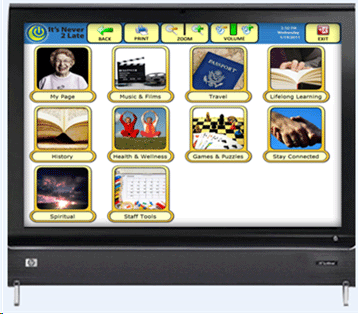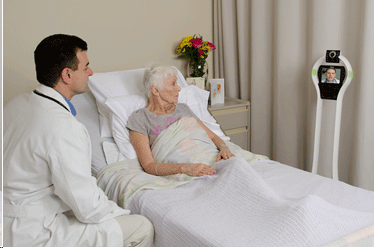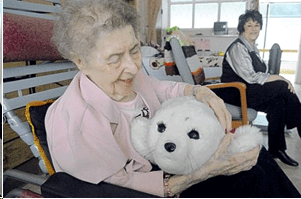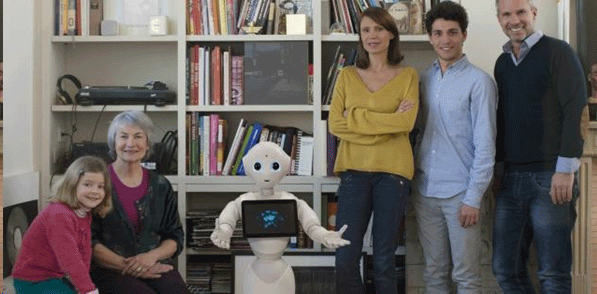 |
|
|
Assistive Technologies for Elder Care |
|
|
|
|
 Figure 1. An engagement platform integrating well-known technologies |
Consider the common way that a family interacts with the elderly, be it in the patient’s home or in a residential care facility. The family typically gathers around the elderly person and simply talks. The topic may be what’s currently going on with family members, neighborhood gossip, perhaps politics, and the like. Often a family member will bring along a traditional photo album with items such as pictures, newspaper clippings, memos, even dried flowers or other items that spark memories in the elderly patient. Home videos and music are popular as well but the elderly really enjoy the human interaction. Let us consider various technical vehicles for duplicating this kind of experience. Figures 1 – 5 show representative samples of commercially-available technologies that can be used for social interaction in order of increasing technical challenge. |
 Figure 2. An interactive avatar integrated with an electronic photo album |
 Figure 3. A tele-presence robot |
 Figure 4. An animaloid robot in the form of a pet seal |
 |
 Figure 5. A humanoid robot |
|
Figure 1 is simply an “engagement platform” that integrates several existing applications, e.g. voice-to-text, video conferencing, cognitive games, movies and shows, electronic photo/video albums, and electronic courses (www.in2l.com). Figure 2 shows an avatar that converses with the patient while showing an electronic photo album. Interestingly, a remote operator, unrelated to the patient, provides textual responses to the patient and a text-to-voice application verbalizes the text in a tone suitable to the avatar (www.gerijoy.com). Figure 3 shows a tele-presence robot with which a doctor or a family member can converse with the elderly patient and drive around a room (www.vgocom.com). Figure 4 shows an anamaloid robot that is responsive to sound and touch, much like a real therapy pet (www.parorobots.com). Finally, Figure 5 shows a humanoid robot that can be programmed to recognize emotions, exhibit emotions, and have conversation with the patient ( www.aldebaran.com). Inevitably, the future will be populated with robots as social companions, assistants, and co-workers. Many entrepreneurs and researchers are gearing up for this kind of future. However, such a future has serious implications having to do with policy, labor, security, acceptance, ethics, personhood, human relationships, technology, cost, management, et al. It is arguable that advances in robotics will influence how we view the world and ourselves as humans, which might cause a philosophical shift in our conceptual and cultural frameworks. An overarching question is the ethical and social ramifications of an elderly patient bonding with a humanoid robot as if the robot were a real human. Consider the managerial implication of robots as social companions. The type of enterprise in which assistive robots would be used is a Continuing Care Retirement Community (CCRC). The CCRC offers housing, healthcare, and services such as education and entertainment to provide quality of life for elderly patients. The organizational structure of a CCRC is typical of most enterprises having to do with housed assisted living. Although types of executives will vary, the traditional CCRC organization consists of an Executive Director reporting to a Board of Directors, a Chief Financial Officer, a Chief Operating Officer, a Chief Information Officer, a Nursing Home Administrator to manage the day-to-day operations of healthcare, and directors of departments such as nursing, medicine, facility management, dining services, marketing, human resources, resident activities, and legal counsel. The staff that work day-to-day with the elderly includes doctors, nurses, physical therapists, and cognitive therapists. Assuming that robot companions prove to be beneficial in experimental trials, a pre-deployment study needs to be made in which the introduction of them into a CCRC is considered from managerial, operational, and legal points of view. The operations of a facility would require careful scrutiny with respect to liabilities, risks, effects on existing healthcare processes, possible process re-engineering, and possible effects on staff members and the elder’s family. For example, the CIO needs to consider whether the facility’s network and computer resources can accommodate the new companions in much the same way that any new information system is considered. The marketing department needs to understand the moral attitudes of potential patients and their families. The Nursing Administrator needs to understand how existing healthcare processes are affected and also consider the attitudes of day-to-day operational staff. The CFO needs to understand the return-on-investment. Most CCRCs do not have Information Security Officers, nonetheless possible security risks need be considered. If a robot can be reached via a wireless network, then there is the possibility of breaching the network and exploiting elderly patients in much the same way that people try to exploit them with email and telephony. More research is needed to understand the managerial implications of electronic social companions. The organization and its operations should be looked at as a dynamic system whose elements may affect one another in unforeseen ways when elements are modified, when elements are introduced or removed, and when new lines of communication are opened. Lundy Lewis is the Christos and Mary Papoutsy Distinguished Chair in Ethics and Social Responsibility at Southern New Hampshire University in the USA (http://www.snhu.edu/14012.asp). He can be reached at l.lewis@snhu.edu. This article will appear in Business Partners (http://bponline.amcham.gr/) and is based on a longer study “Avatars and Robots as Social Companions in Healthcare: Requirements, Engineering, Adoption and Ethics” in the International Journal of Enterprise Information Systems, IGI Global Press, April-June 2014, Vol. 10, No. 2 (http://www.igi-global.com/article/avatars-and-robots-as-social-companions-in-healthcare/112076) |
|
|
(Posting date 16 August 2014) HCS encourages readers to view other articles and releases in our permanent, extensive archives at the URL http://www.helleniccomserve.com/contents.html, especially our sections on Business and Business Ethics and for the Papoutsy Chair in Ethics and Social Responsibility at Southern New Hampshire University. |
|
|
|
|
2000 © Hellenic Communication Service, L.L.C. All Rights Reserved.
http://www.HellenicComServe.com |
|
